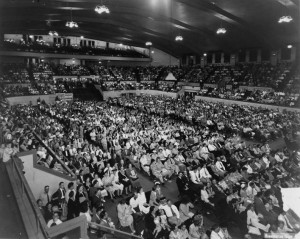Keeping the Torch Burning: Our First National Youth Congress
August 1946 brought eventful days to delegates meeting in Birmingham, Alabama, for the 41st General Assembly of the Church of God. Some of the excitement was likely because this was the first full meeting of ministers and members in several years. The war years had demanded travel restrictions, and the previous Assembly in 1945 was limited primarily to Bishops.
Much of the excitement in 1946 was due to the energy and enthusiasm of thousands of youth participating in the first Church of God National Youth Congress. Held August 27-28, youth from the United States and twenty-one other nations filled the Birmingham Municipal Auditorium to worship, study and commit themselves to the work of their Lord.

Delegates filled the Birmingham Municipal Auditorium for the 1946 National Youth Congress and General Assembly.
Although the Church of God had had a general youth program in the form of the Young Peoples Endeavor (YPE) since 1929, there was not yet a general department to focus on the needs of youth. This congress had been planned by an annually appointed National Youth Committee. But on the final night of the congress, General Overseer John C. Jernigan announced that Tennessee youth director Ralph E. Williams would become the first national youth director for the Church of God.
The conference included morning, afternoon and evening worship services. Breakout sessions each morning gave young people an opportunity to study issues and make recommendations to the Bishops’ Council regarding the role of youth in the areas of missions, education, evangelism, the Bible School, music, literature and recreation.
Woodrow Wilson Park was the site of an outdoor missions rally on Tuesday afternoon. Delegates from Africa, Hawaii (not yet one of the Untied States), Puerto Rico and Guatemala gave testimonies. Carl Hughes, overseer of the West Indies and Bermuda, challenged those called to be missionaries to be filled with the Spirit. Twenty-five came forward and over a hundred raised their hands as a testimony that they would commit their lives to world missions.
Music was a highlight of the congress. Among the singers were Vep Ellis and the nationally known LeFevre Trio. The LeFevres sang “Going Up When I Die” and “The Land of Eternal Spring.” Like many young men, Alphus and Urias LeFevre had recently returned from overseas military duty. They expressed thanksgiving for the many prayers of the church for their safety and proclaimed that they were glad to “be back on the battlefield for God.” According to the congress reporter, the LeFevres’ “accomplished singing brought down the house, while Alph wrought miracles on the keyboard.”
Harry Kutz and Alphus LeFevre accompanied Vep Ellis as he sang “The Meeting in the Air.” The congregation responded with “about five minutes of old-time holiness shouting.” When the shouting ebbed, Manuel Campbell, Texas youth director and the service moderator, promised the Church of God that if “older folks” would provide the fuel, the youth would “keep the torch burning.”
————————————–
This article was written by Church of God Historian David G. Roebuck, Ph.D., who is director of the Dixon Pentecostal Research Center and assistant professor of the history of Christianity at Lee University. This “Church of God Chronicles” was first published in the August 2003 Church of God Evangel




